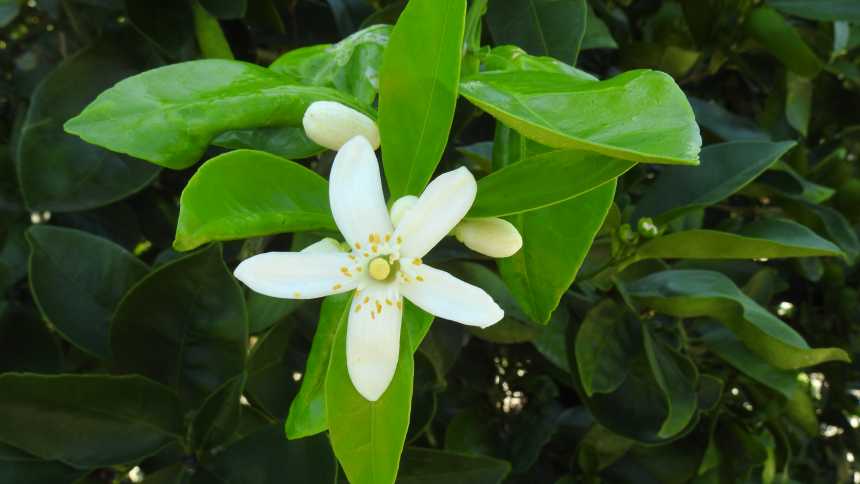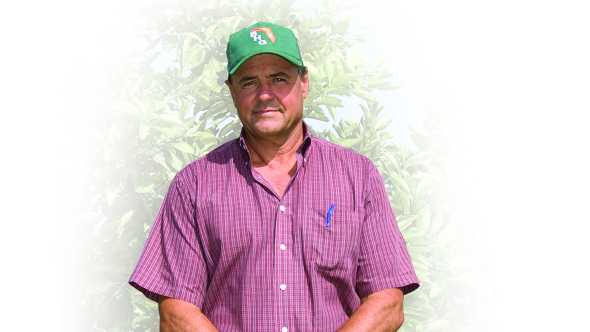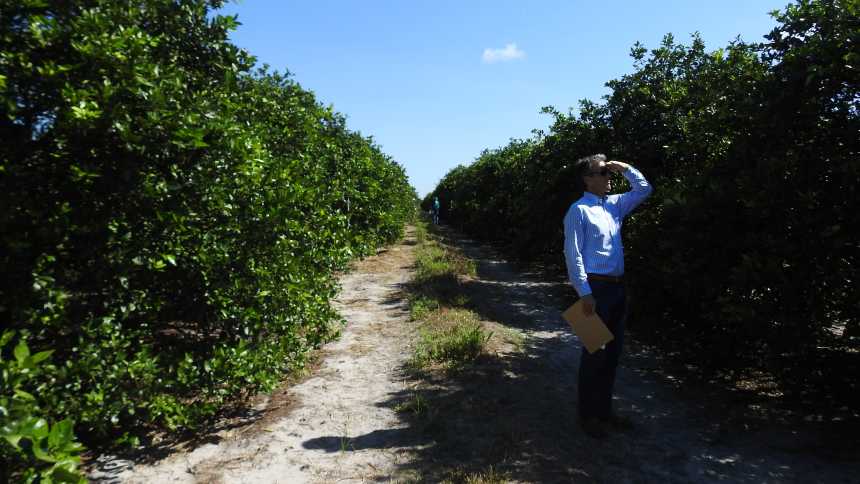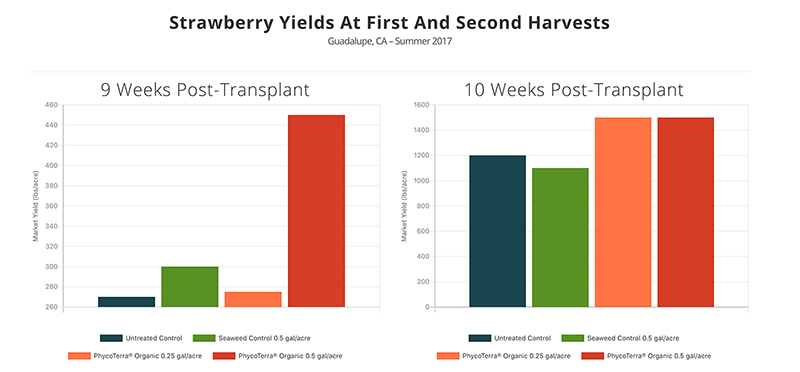Florida Citrus Groves Under Siege From Postbloom Fruit Drop

Classic symptoms of postbloom fruit drop are buttons left where fruitlets have dropped off. It’s also a sign the fungus is present in the grove.
Photo by Frank Giles
The notion that anything would knock HLB out of the headlines in the Florida citrus industry is hard to believe, but postbloom fruit drop (PFD) has grabbed the attention of growers across the state. For the past three seasons, the ailment has come back and is epidemic in some groves.
While HLB clearly enhances PFD, the problem, caused by the fungus Colletotrichum acutatum, has been around for a long time, being first formally described in Belize in 1979. The fungus will infect flowers of all species of citrus, creating orange-brown lesions in the blooms. The fruitlets will then drop leaving buttons behind. In more normal years, PFD effects Navel and Valencia, however this past season, Hamlins also were impacted.
According to the 2016 Florida Citrus Pest Management Guide, most spores of the fungus are produced directly on the surface of infected petals.
Spores are dispersed by rain to healthy flowers where they infect within 24 hours and produce symptoms in four to five days. The fungus survives between bloom periods as resistant structures on the surface of leaves, buttons, and twigs. Flowers are susceptible from the pin-head stage (with white tissue present) until they are open.
HLB’s involvement comes with erratic bloom it has triggered in citrus trees, which makes it more difficult for growers to time fungicide applications for maximum efficiency.
“HLB causes the tree to flower all year,” says Megan Dewdney, Associate Professor of Plant Pathology with UF/IFAS. “In nearly every block, there will be flowers somewhere. There is enough to keep the fungus active and ready to infect the next set of flowers.”
Conditions were ripe for PFD during the past three seasons’ main bloom, with each passing season building up more inoculum. The El Niño weather pattern brought rain during bloom, which grows and spreads the fungus.
Henry Yonce, Owner of the consulting firm KAC Agricultural Research, says PFD was as bad as he has ever seen this past season.
“The PFD was severe in Navel and Valencia this season,” he says. “It was by far the worst I’ve seen in citrus, and I have been working in Florida since 1984.”
Yonce heard of one Valencia grove in the Immokalee area that picked 600 boxes per acre two seasons ago. The same grove picked 150 boxes this season, and the grower reports the PFD was so severe there might not even be enough fruit to spray for next season.
“Last season was particularly bad because bloom lasted in some cases from November through April because of the lack of cold weather over the winter,” Dewdney adds. “There were two seasons of inoculum built up in those trees.”
USDA’s first forecast for the 2016-2017 Florida orange season will be __________ 80 million boxes.
- Less than (78%, 145 Votes)
- Greater than (12%, 22 Votes)
- Equal to (10%, 19 Votes)
Total Voters: 186
While PFD has historically not been a problem in Hamlins, growers did report problems last season. Yonce adds growers better be vigilant for drop next spring in bloom, even in Hamlins.
“The Hamlins have not really been susceptible to PFD in the past, but there is so much inoculum out there right now, we are seeing it show up in other varieties like Hamlins and tangerines. It is starting to get a foothold in these varieties, so if we have rainfall next year in bloom, I would recommend spraying Hamlins.”
In late June, the Citrus Research and Development Foundation hosted a special meeting of its Research Management Committee to hear from a cross-section of scientists with experience in PFD. A summary of that meeting is available from the Foundation at Citrusrdf.org.

Sporadic bloom due to HLB has allowed postbloom fruit drop to proliferate.
Photo by Frank Giles
Actions In Bloom
According to Yonce, there is really not much to scout for when it comes to PFD. If rainy conditions are right, he advises be ready to act.
“If you have buttons on trees and inoculum, you better be ready to spray,” he says. “If the forecast says rain and it is a time during heavier bloom, I would start my sprays a few days before the rain and then after rain just to be sure I get my acres covered.”
Currently, strobilurin-based fungicides are the primary tool used in fighting PFD. Ferbam (ferric dimethyldithiocarbamate) also can be used in a tank mix with strobilurins.
“The strobilurins mixed with another fungicide seem to be the best option,” Dewdney says. “We have several other fungicides in trials but not enough data yet collected to comment.”
Topsin M (thiophanate-methyl) also has shown activity against the PFD fungus, but does not have a citrus label. There are discussions ongoing about seeking a Section 18 clearance to use the product.

Steve Farr, Vice President of Ben Hill Griffin Inc.’s Grove Division, says he is still trying to determine the best course of action to fight PFD.
Photo by Frank Giles
Steve Farr, Vice President of Ben Hill Griffin Inc.’s Grove Division, says PFD is some of the worst he has seen since the early 1990s. Like other growers, he is still trying to determine the best course of action to fight the disease.
“It looks like we did some good with two to three applications of strobilurins, but it’s not definitive,” Farr says. “It varies depending on which tree or limb you look at, but where no applications were done, PFD was definitely a heavier hit.”
He adds evaluation of treatments is very difficult because of the inconsistencies in bloom and tree health brought on by HLB. It also makes timing of applications a challenge.
“We have had significant disease pressure the last two years in a few blocks, thus we were looking for PFD and unfortunately found plenty of it in February from the December/January bloom on HLB trees,” Farr says. “So, we started weekly applications on Valencia and Navel blocks the first week of March, which was what we felt was the main bloom.
“By the third week of March, we did not see significant disease pressure. We also greatly appreciated the dry period from February 24 through March 19. We pulled back on the third application for economic reasons as well as seeing less pressure in several areas. But, we did apply a third spray on all Navel and Valencia blocks that were hit the previous two years.”
Farr adds he is seeing buttons now in almost all blocks and varieties, which has not been observed before.
“Hopefully, a few buttons in a grove is not a major economic factor, but it does tell us the disease is now in all varieties and blocks,” he says. “We do have some early varieties that will be affected with a crop reduction from PFD for the first time.”
Actions Outside Of Bloom
During a recent PFD field day, growers were asked what appeared to be working best against the disease. One grower joked, “A bulldozer.”
Joking aside, there is very little growers can do outside of bloom applications of fungicides. However, Natalia Peres, UF/IFAS Associate Professor of Pathology, says tree removal is a consideration.
“Removal of declining trees is about the only thing a grower can do [outside of bloom],” she says. “Those trees bloom early and increase the inoculum, which spreads to healthy trees.”
Hoping For A Drier Bloom
Outside of new fungicide options, growers can pray for a drier bloom period next season. That can do a whole lot to eliminate the problem. Given the last major outbreaks of PFD came in El Niño years, with the current El Niño all but gone, a drier bloom might be in store.
“Since we are not predicted to be in an El Niño climate pattern for this year, I am hoping the better weather conditions will do as much as any control measure for PFD in the upcoming season,” Dewdney says. “I really hope for a much lower disease pressure in the upcoming year, but I think PFD will be a regular problem if trees with HLB continue to have off-season bloom. We all will need to be highly vigilant and be prepared to take action as soon as it is needed.”

Growers braved a hot day to evaluate fungicide treatments aimed at fighting postbloom fruit drop.
Photo by Frank Giles
PFD Field Evaluation
Postbloom fruit drop has been a big topic of discussion among growers. In June, BASF hosted a grower field day to evaluate various fungicide applications aimed at PFD. Attendees conducted a blind evaluation of 19 different treatments and combinations of products with four replications. The plots received three applications during the bloom in March.
Plots were graded one to five — one being worst and five best. The growers scored Headline (pyraclostrobin, BASF), Topsin M (thiophanate-methyl), and Abound (azoxystrobin, Syngenta) as the best looking plots in the evaluation. However, due to the severity of PFD, none of the plots scored very high marks.
KAC Agricultural Research conducted the trial. In its own evaluation, Abound at 15.4 ounces per acre and Topsin M at 2 pounds per acre scored as the best treatments. Yonce says his methodology included a 3-foot-by-3 foot frame held about chest high on both sides of the center three trees of each plot. Button counts and fruit counts were taken inside the frames. In addition, counts of 15 seconds were taken of visible fruit on each side of the three trees.










